CES Preview - Micron's RealSSD C300 - The First 6Gbps SATA SSD
by Anand Lal Shimpi on January 7, 2010 12:00 AM EST- Posted in
- Trade Shows
I bumped into Nathan Kirsch of Legit Reviews and Jansen Ng of DailyTech while I was picking up my CES badge yesterday. They both had Storage Visions badges. I didn't have one. I felt left out.
It got worse when they told me that they just saw Micron's new SSD - the RealSSD C300. Both of them said it looked damn good. I felt extra left out.
Then they told me that Kristin Bordner, Micron PR, was looking for me and wanted to give me a drive. Things started looking up.
I made the trek over to the Riviera today to meet with Micron and take a look at their RealSSD C300. SSDs are difficult enough to evaluate after months of testing. They're basically impossible to gauge from a one hour meeting in a casino ballroom.
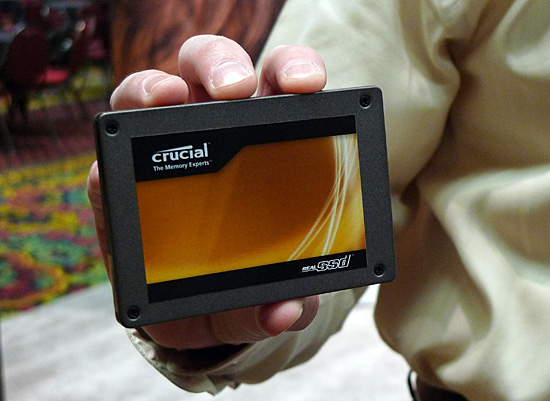
Faster than Intel? Perhaps.
The C300 is based on a new Marvell controller. It's the first consumer SSD to natively support 6Gbps SATA. The firmware and all of the write placement algorithms are developed internally by Micron and its team of 40 engineers. Micron tried using Marvell firmware in the past and quickly learned that it resulted in too much of a "HDD-like" experience (ahem, JMicron).
The Marvell controller features two ARM9 processor cores that operate in parallel. While they can load balance, one generally handles host requests while the other handles NAND requests.

Two ARM9 processors, Micron firmware, 256MB of external DRAM and 8-channels of MLC NAND flash
Adjacent to the controller is a massive 256MB DRAM. According to Micron, "very little" user data is stored in the DRAM. It's not used as a long term cache, but mostly for write tracking and mapping tables.
The controller internally doesn't have much cache on-die. Not nearly as much as Intel, according to Micron. While the original X25-M only had a 512KB SRAM, Micron claims that the latest G2 controller has a 2MB cache on-die. Micron x-rayed the chip to find out.
The write placement algorithms are similar in nature to what Intel does. There's no funny SandForce-like technology at work here. Every time a write is performed the controller does a little bit of cleanup to ensure that the drive doesn't get into an unreasonably slow performance state. Unlike Intel however, Micron does do garbage collection while the drive is idle. The idle garbage collection works independently of OS or file system.
TRIM is supported but only under Windows 7. There are no software tools to manually TRIM the drive. Micron hopes that its write placement algorithms and idle garbage collection will be enough to keep drive performance high regardless of OS.
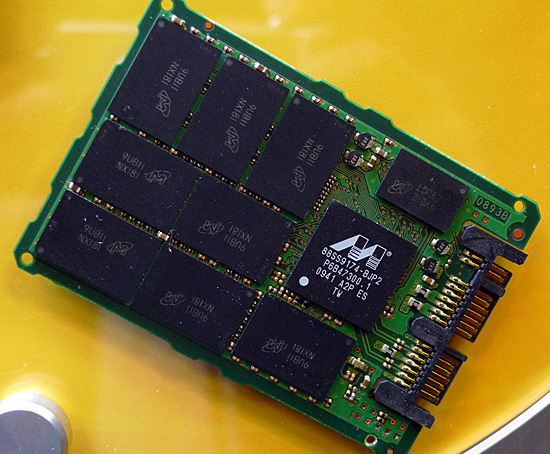
The RealSSD C300 will also be available in a 1.8" form factor for OEMs
Supporting 6Gbps SATA isn't enough to drive performance up. Micron is also using 34nm ONFI 2.1 NAND flash. The combination of faster NAND and a faster interface results in sequential read speeds of as much as 350MB/s. That's a full 100MB/s greater than the SandForce based OCZ Vertex 2 Pro we just previewed.
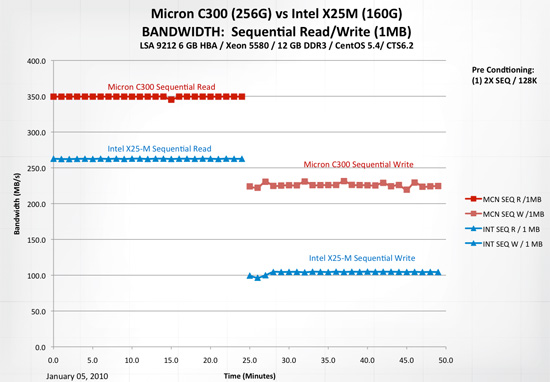
Write speeds don't set any records though. Micron claims the drive will do 215MB/s on sequential writes.
Random 4KB read/write speed appears to be X25-M class if not better. Micron only showed off peak numbers for a very short iometer run so we'll have to wait for me to get a drive before I can get a good idea of random performance.

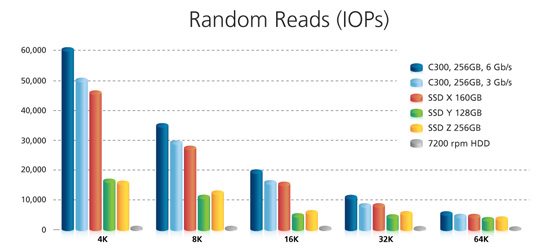
Micron does claim that the drive is more resilient than Intel's X25-M. Running a pure 4KB random write test across the entire drive's LBA space for 250 minutes (!) resulted in the following data:
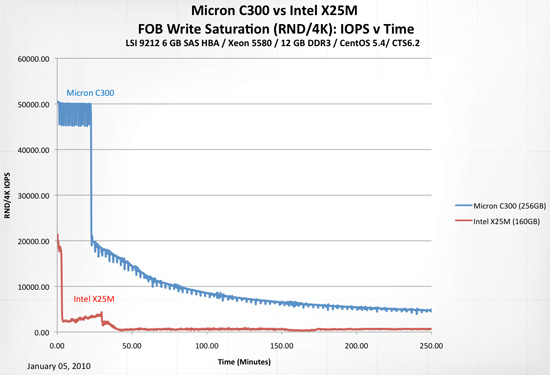
This workload is far more severe than anything you'd find on a desktop PC, but it does show that the RealSSD C300 appears to be fairly resistant to steep performance drops. The drive is completely unused prior to this test however.
PCMark Vantage performance is pretty impressive. On a SATA 3Gbps controller it appears to equal Intel's X25-M G2, but with a 6Gbps controller it is 23% faster if Micron's numbers can be believed.
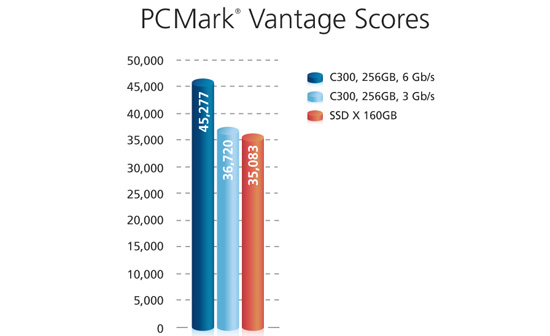
The issue of compatibility testing is a, err, non-issue. Micron already has a large compatibility lab for its memory. It just tests SSDs in the same lab now. Because Micron is going to be selling to OEMs the drives have to pass a 1000 hour qualification test before they can ship. The consumer drive will need 500 hours of test time before it can ship.
The Micron RealSSD C300 will be OEM-only, going after the same markets as Intel, Samsung and Toshiba. Crucial, Micron's retail arm, will sell direct to retail.
The Crucial RealSSD C300 will be available in two capacities: 128GB and 256GB with 7% of the NAND capacity used as spare area. The drives will be priced at $399 and $799 respectively. OEMs will get drives starting at the end of this month, but the Crucial drives will be available for purchase in February.
I'm already on the list for a review sample, so for now we wait.










33 Comments
View All Comments
supremelaw - Thursday, January 7, 2010 - link
http://www.newegg.com/Product/Product.aspx?Item=N8...">http://www.newegg.com/Product/Product.a...82E16813...OOPS! My mistake:
I thought those 4 x white SATA ports were all 6G.
On close examination, I now see:
GSATA3_6
GSATA3_7
GSATA2_8 <--- SATA/3G (300 MB/second)
GSATA2_9 <--- SATA/3G (300 MB/second)
In line with the published specs,
GSATA2 = Gigabyte SATA-II
GSATA3 = Gigabyte SATA-III (6G).
MRFS
itsjustausername - Thursday, January 7, 2010 - link
I'm considering the GIGABYTE GA-X58A-UD7 myself.
So I'm curious, when you say,
"We need motherboards ... like this GIGABYTE GA-X58A-UD7"
ss your emphasis on improvements in price or features?
Except for the cost, how do you feel about the UD7?
tygrus - Thursday, January 7, 2010 - link
Just think what another 4 or 8 channels of Flash could achieve? saturate 6Gbps SATA.Still good to buffer writes to fill whole block accross all channels at once instead of repeated writes. May be we need better IO driver in OS to buffer small writes ?
tygrus - Thursday, January 7, 2010 - link
I hear some OCZ employees nearly cried when they saw the random write performance of the new Micron based RealSSD C300 compared to the hard work put into the "Vertex 2 Pro".Will we have one SSD to rule them all ?
lensman0419 - Thursday, January 7, 2010 - link
I'm pretty sure OCZ didn't develop any of the Sandforce based firmware. They are a re-brand and sell kind of operation, they can always re-brand a Micron C300 as OCZ C300 hehehnerdtalker - Thursday, January 7, 2010 - link
Looks like Intel seriously needs to bring its A game to the table to reclaim dominance in the SSD realm.Considering how soundly it "Conroe'd" the market with the X-25 G1, I would've expected a bit more out of its market lead with the G2 and incremental firmware updates for both than what's currently going on.
So much of the performance increase seems to be from algorithmic changes on the controller, stuff that really doesn't seem so computationally intensive that it requires new architecture or ASIC (since they're just using straight ARM) but rather entirely procedural.
I have no allegiance to intel SSDs, but here's to hoping intel figures something special and intrinsic about leveraging NAND to speed up its drives before it gets left behind.
semo - Thursday, January 7, 2010 - link
I think Intel's main aim is to satisfy OEMs. Performance is nice but it doesn't make them much profit if only enthusiasts buy it. Its hard enough explaining the benefits of SSDs to some anandtech and dailytech readers (SSDs are for performance not for mass storage!) let alone the average consumer. The best you can do is educate people that HDD == Bad, SSD == Good. Information such as reliability, performance figures under varying usage patterns, firmware upgrades, TRIM and interface is completely ignored.OEMs are looking for something robust (which the boring samsung drives are) and i imagine that's what Intel wants to appear as. Sure they had some data corruption issues but it seems sorted now, plus the average consumer wouldn't be doing firmware updates for their storage device.
yyrkoon - Saturday, January 9, 2010 - link
That, and the fact that Microns drives are the using the newer SATAIII spec, where the Intel drives are not. Not only this, but Microns claims are unsubstantiated at this point in time.Having dealt with Crucial/ Micron for many years, I do not necessarily doubt their claims. I tend to trust their products first, until proved otherwise. But the same could be said for Intel as well.
So the Op on this subject is jumping the gun a bit. We will see when things actually come into the light.
yyrkoon - Saturday, January 9, 2010 - link
That, and the fact that Microns drives are the using the newer SATAIII spec, where the Intel drives are not. Not only this, but Microns claims are unsubstantiated at this point in time.Having dealt with Crucial/ Micron for many years, I do not necessarily doubt their claims. I tend to trust their products first, until proved otherwise. But the same could be said for Intel as well.
So the Op on this subject is jumping the gun a bit. We will see when things actually come into the light.
Makaveli - Thursday, January 7, 2010 - link
Can't wait to see that review. Hopefully the numbers stay this good it might force intel to release a refresh sooner than Q4. I was expecting a bigger boost in read speed on SATA 6 Gpbs, guess we will have to see what the successor to ICH10R can do.